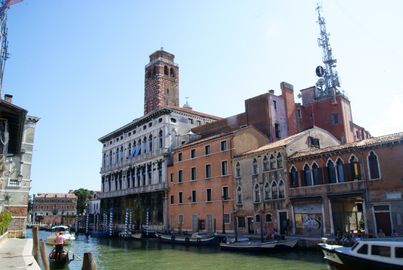

This waterfront derives its name from the Italian word "zattera," meaning raft. In Venice it is usually just called the Zattere. In the early years of the Venetian Republic, long before the creation of any type of solid quay, rafts transporting logs and trunks would dock at this shore. The wood would then be used to create piles, which would be driven into the seabed for holding up the foundations of streets and buildings. The Zattere itself was laid over millions of such piles in the early 16th century. It measures two kilometers in length and anywhere from three to twenty meters in width. There are several very good restaurants that can be found on the waterfront - the most democratic being at the part by the Port Authority and the most aristocratic - by the Punta della Dogana. From May to October the Zattere is packed with sunbathers sprawling on the edge of the concrete, kicking up water with their feet.
The long strip of land that stretches on the other side of the Giudecca Canal is the Island of Giudecca itself. Experts still have not found the truth behind the name "Giudecca." Some say that it derives from the Latin "Judaica," implying that the island once was inhabited by a Jewish community. However, this theory does not hold up because the first Venetian Ghetto was instituted in 1516 in the Sestiere of Cannaregio. Someone also interpreted the name as a derivation of "giudicati," which means condemned, with reference to the wrongly condemned families who were compensated with land on the island. Another theory is that the island was inhabited by tanners who used substances called Zuec, Zueccam and Zuecchi. Whatever the truth is, one thing is certain: in the beginning of Venetian civilization this island was called Spinalonga, meaning Long Thorn.
In the glorious days of the Venetian Republic the Giudecca was bestrewed with lush gardens and large palaces. In the 20th century it grew more industrial, with shipyards and factories being the main attractions. Before World War I it even boasted a small film studio. After the war it experienced a long period of decline and only recently, in the last ten years, has returned to popularity. Today the Giudecca waterfront is lined with sumptuous celebrity-owned apartments overlooking the bay. The Giudecca even offers a more spectacular view of the city than the Zattere. However, the problem is getting there. The vaporetti connecting the Giudecca to the Zattere do not run as often as the regular ones, and it can be confusing finding the right one. Yet, if the right vaporetto is found, the experience is worthwhile. The only other problem is getting back of course.